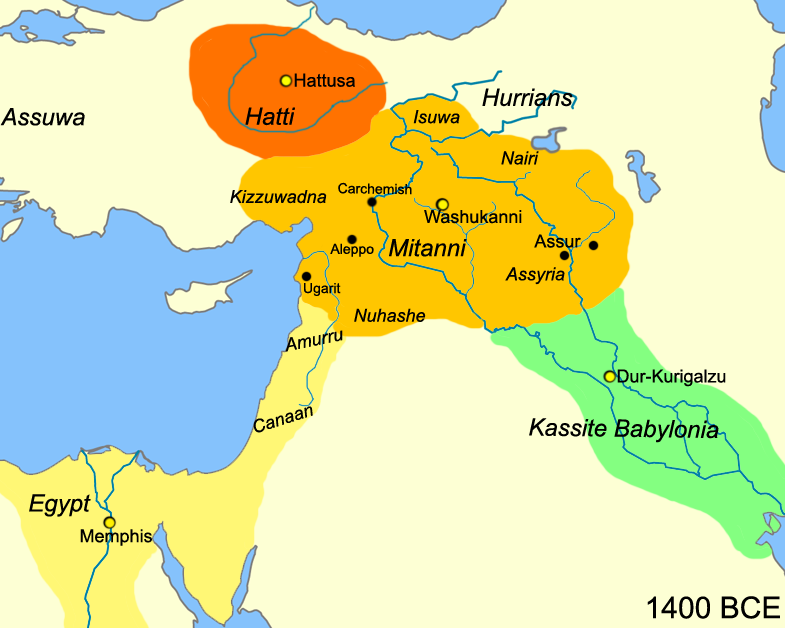|
Thutmose III: The Battle of Megiddo
ca. 1482 BCE
An alliance of Canaanite cities was headed by the king of Kadesh on the Orontes and the king of Megiddo. In order to suppress them Thutmose III marched his army in ten days from his border fortress of Sileh to Ghaza, the main Egyptian stronghold in Canaan.  " width="320" height="470" alt="[Image: The battle of Megiddo]" /> " width="320" height="470" alt="[Image: The battle of Megiddo]" />
After another eleven days they reached Yaham, where they held a war council.
It was known that the Canaanites had concentrated their forces near Megiddo to which there were three access routes: The northern and southern routes were longer than the central route through Aruna, but were less easily defendable. The generals had, as it turned out wrong, intelligence about the Aruna route being blocked by Canaanite forces and counselled the pharaoh to take the Yokneam or Taanakh route.
'Now two (other) roads are here. One of the roads ( behold, it is [to the east of] us, so that it comes out at Taanakh. The other ( behold, it is to the north side of Djefti, and we will come out to the north of Megiddo. Let our victorious lord proceed on the one of [them] which is [satisfactory to] his heart, (but) do not make us go on that difficult road!'
Inscription from the Amen Temple at Karnak.
J. B. Pritchard Ancient Near Eastern Texts, 1969: p. 234.
Thutmose rejected the arguments of his generals, set out on the Aruna route and reached the river Qinah south of Megiddo without encountering any opposition.
It was then that the disposition of the Canaanite forces became clear. A contingent of footsoldiers guarded the southern road from Taanakh, while the northern approaches of Megiddo were held by more infantry. The chariots were concentrated around Megiddo itself, waiting for the Egyptian forces to attack the footsoldiers who would quickly retreat as if they were fleeing.The pursuing Egyptians would break ranks and could be attacked by the hidden Canaanite charioteers.
Behold, His Majesty has come forth together with his victorious army and they have filled the valley; let our victorious lord hearken to us this once, and let our lord await for us the rear of his army and his people. When the rear of the army has come right out to us, then we will fight against these Asiatics and we shall not have no trouble about the rear of our army.
The Egyptians rested during the night and disposed their forces in three wings. The attacking Canaanites were routed and so hotly pursued, that the defenders of Megiddo refused to open the gates and pulled their fleeing charioteers over the walls to safety. Instead of attacking the city the Egyptians began to loot the abandoned camps, which gave the Canaanites time to organise their defense.
Would that the army of His Majesty had not set their hearts upon looting the chattels of those enemies, for they would have captured Megiddo at that moment, while the vile enemy of Kadesh and the vile enemy of this town were being hoisted up.
The conquest of Megiddo and its inhabitants was vital; and it fell after a siege of seven months.
All the princes of all the northern countries are cooped up within it. The capture of Megiddo is the capture of a thousand towns.
Thutmose led many more campaigns into Canaan, and eight years after the battle of Megiddo he took Kadesh on the Orontes. Following the conquest of Retenu, he built a big navy, which was instrumental in his extending Egyptian influence over much of the littoral Near East. His army could reach any coastal town in Syria by ship in four to five days, while by foot the journey would take more than a fortnight. Surprise became a major weapon in his arsenal.
[ ] The map is drawn after a map in Carta's Atlas of the Bible by Yohanan Aharoni, Jerusalem, 1964, p.32
|
![[Image: Canaanite charioteer hit by an arrow]](http://www.reshafim.org.il/ad/egypt/canaanite.jpg)
![[Image: Canaanite charioteer hit by an arrow]](http://www.reshafim.org.il/ad/egypt/canaanite.jpg)



